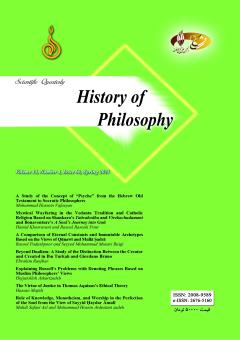Mystical Wayfaring in the Vedanta Tradition and Catholic Religion Based on Shankara’s Tattvabodha and Vivekachudamani and Bonaventure’s A Soul’s Journey into God
Subject Areas : New analyses and findings in the field or Oriental wisdomHamid Khosravani 1 * , Rasoul Rasoulipour 2
1 - PhD Candidate of Kalam, Shahid Motahari University, Tehran, Iran
2 - Associate Professor, Philosophy Department, Kharazmi University, Tehran, Iran
Keywords: Shankara, Bonaventure, Advaita Vedanta, Christian theology, Mind, sense,
Abstract :
This paper, following a descriptive-analytical method, provides a comparative analysis of two spiritual systems: Shankara's six essences in the Vedanta tradition and Bonaventure's six spiritual exercises in Christian theology. Both systems seek human perfection and the knowledge of absolute truth, and their goal is to guide the individual towards union with absolute truth. The main question here is to examine the similarities and differences between these two systems regarding their structure, stages, and goals, despite their specific contexts and perspectives. The importance of the present study lies in identifying the commonalities and differences between these two mystical systems, as it can contribute to a deeper understanding of the shared dimensions of spiritual experiences in religious traditions and explore how these systems adapt to the spiritual challenges of contemporary humanity. This comparison can also serve as a bridge for intercultural and interreligious dialogues and interactions. This research aims to make a comparative analysis between Shankara’s six ascetic methods and soul purification and Bonaventure's six spiritual exercises to clarify their overlaps and differences in methodology, goals, and approaches. It has been tried to accomplish this task by investigating certain texts such as Shankara’s Tattvabodha and Vivekachudamani and Bonaventure’s works.
Vedanta Kesari (1967). He who holds in hand the wheel of the chariot. Vedanta Kesari, vol. 53, p. 479. Chennai, India: Sri Ramakrishna Math.
Bonaventure (1978). The soul’s journey into God. in E. Cousins (ed. & trans.), Bonaventure: The soul’s journey into God, the tree of life, the life of St. Francis. New York: Paulist Press. (Original work published 1259) https://ixtheo.de/Record/1129069826
Clooney, Francis X. (2010). Comparative Theology: Deep Learning Across Religious Borders. Malden: Wiley-Blackwell.
Deutsch, K. W. (1980). A voyage of the mind, 1930–1980. Government and Opposition, vol. 15, no. 3-4, pp. 323-345. https://doi.org/10.1111/j.1477-7053.1980.tb00281.x
Dimock, E. C., Jr. (1963). Doctrine and practice among the Vaishnavas of Bengal. History of Religions, vol. 3, no. 1, pp. 106-127. https://doi.org/10.1086/462474
Goswami, H. D. (2008). For whom does Hinduism Speak?; https://www.hdgoswami.com/lecture-location/usa/page/2 /
Heim, M. (2005). Differentiations in Hindu Ethics. in W. Schweiker (ed.), The Blackwell Companion to Religious Ethics. Blackwell.
Krishnan, M. (2023). A study of metaphor: Upanishadic “Ratha Kalpana” and Emily Dickinson’s “The Chariot”. Quest Journals: Journal of Education, Arts, Law and Multidisciplinary, vol. 13, no. 1, pp. 11-13.
Lee, Yongho Francis (2020). Mysticism and Intellect in Medieval Christianity and Buddhism: Ascent and Awakening in Bonaventure and Chinul. Lanham: Lexington Books.
Macquarrie, J. (2005). Two worlds are ours: An introduction to Christian mysticism. Minneapolis: Fortress Press.
Madhavananda, S. (1921). Vivekachudamani of Sri Sankaracharya. Mayavati: Advaita Ashrama.
Madhavananda, S. (2000). Brihadaranyaka Upanishad. Common Books.
Mahavakyas (2019). Ayam Atma Brahma: Self is Absolute Entity. http://www.classicyoga.co.in.
Malkovsky, Bradley (1999). Advaita Vedānta and the Christian faith. Journal of Ecumenical Studies, no. 36, pp. 397-422. https://ixtheo.de/Record/1642763365
Manring, R. (2005). Reconstructing tradition: Advaita Ācārya and Gauḍīya Vaiṣṇavism at the cusp of the twentieth century. New York: Columbia University Press.
Moorman, J. R. H. (1968). A History of the Franciscan Order from Its Origins to the Year 1517. Oxford: Clarendon Press.
Narasingha (2022). Bhagavad Gītā. Gauranga Vani Publishers.
Nikhilananda, S. (1946). Self-knowledge (Ātmabodha): An English translation of Śaṅkarāchārya’s Ātmabodha, with notes, comments, and introduction. New York: Ramakrishna-Vivekananda Center.
Olivelle, P. (2008). Upanisads: A New Translation by Patrick Olivelle. Oxford University Press. (Original work published 1996).
Paramarthananda, Swami (2008). Tattvabodha. Vedanta Study Circle, Athens, Greece.
Paramarthananda, Swami (2024). Vivekachudamani. Arsha Avinash Foundation.
Ramakrishna (2023). Purity of Mind. New York: Vivekananda Center. Available at https://ramakrishna.org/purity1.html
Raphael, E. (1992). The pathway of non-duality, Advaitavada: An approach to some key-points of Gaudapada's Asparśavāda and Śaṁkara's Advaita Vedanta by means of a series of questions answered by an Asparśin. Nataraj Books.
Shankaracharyaji, Adi (2011). Tattva Bodha: Basic Vedanta terms & definitions. Reflections by Swami Gurubhaktananda on the 51 lectures delivered by Swami Advayananda, Acharyaji, 15th Batch Vedanta Course, Sandeepany Sadhanalaya, Powai, Mumbai.
Soars, Daniel (2023). The World and God Are Not-Two: A Hindu–Christian Conversation. New York: Fordham University Press. https://doi.org/10.1111/moth.12927
Sunirmalananda, Swami (2005). Insights into Vedanta: Tattvabodha. Chennai: Sri Ramakrishna Math.
Vivekananda, S. (1970). The complete works of Swami Vivekananda. Vol. 2. Mayavati: Advaita Ashrama.
Wood, Ernest (2013). Great systems of Yoga. Literary Licensing, LLC.
Xiong, L. (2005). Bonaventure and medieval mysticism. Logos & Pneuma: Chinese Journal of Theology, vol. 22, pp. 81-98.

